Abstract
Ensuring thermal comfort in waiting areas is essential for visitor satisfaction and well-being. In the context of nearly zero-energy buildings (nZEBs), these spaces—typically characterized by short-term occupancy, transient user behavior, and the need for rapid temperature adjustment—pose specific challenges for HVAC control in balancing comfort and energy demand. This study investigates the influence of a ceiling-mounted fan coil unit (FCU) operating in heating mode on thermal comfort conditions in an nZEB office waiting area. Measurements were conducted at multiple points within the space to assess microclimate parameters, followed by the calculation of the predicted mean vote (PMV) and predicted percentage of dissatisfied (PPD) indices, supported by occupant feedback collected through short interviews. The results showed that although the FCU effectively increased the average temperature, its intermittent operation and localized air jets during the heating phase caused temporary discomfort near the unit. Occupant feedback confirmed sensations of discomfort due to strong air movement during FCU operation but indicated slightly higher overall dissatisfaction and smaller variability compared to model-based PPD values, reflecting the averaging effect of occupant perception over time. These findings highlight the need for optimized FCU control strategies in waiting areas, such as operating at reduced fan speeds and preheating the heat exchanger, to enhance occupant comfort. This study contributes to improving HVAC control concepts for semi-transient spaces in nZEBs.
1. Introduction
The need to design energy-efficient buildings arises from current regulatory requirements. In European countries and many others, new regulations have introduced mandatory standards for nearly zero-energy buildings (nZEB) []. The implementation of these standards is closely linked to successive revisions of the European Energy Performance of Buildings Directive (EPBD) [,,,]. In addition to minimizing energy consumption, reducing the environmental impact of buildings throughout their life cycle is essential []. An equally important but often underestimated design criterion is user comfort. This aspect, although fundamental, is sometimes overshadowed by the focus on energy efficiency. The basics of studying thermal comfort were formulated in the 1970s by Fanger [].
Since then, research on thermal comfort has significantly evolved. In [], the authors reviewed developments in indoor thermal comfort research and practice since the late 1990s, highlighting two main areas: thermal comfort models and standardization, and the role of computerization in building performance assessment. Piasecki [,] demonstrated the practical application of an indoor environmental quality (IEQ) model for assessing both a retrofitted historical masonry building and a single-family building with near-zero energy consumption. Other studies [,,] analyzed features of the building envelope that strongly influence the summer indoor microclimate in low-energy buildings, introducing the concept of “passive overheating protection measures”. The adaptive comfort method was used as a criterion for evaluating indoor conditions, emphasizing the possibility of achieving comfort without mechanical cooling, thus reducing energy demand. Similar conclusions were reached in [], where the effectiveness of outdoor shading elements was investigated during the transitional season, showing that passive measures alone may not ensure comfort throughout the year and temporary mechanical conditioning may still be necessary. Mechanical air conditioning often causes uncomfortable draughts and increased air movement for users. Scientists have taken this aspect into account in their research [,]. Other studies [,] expanded the topic of thermal comfort to include indoor air quality aspects.
Waiting areas, commonly found in buildings such as office complexes, public administration facilities, transport terminals, or healthcare centers, are specific indoor environments that require careful provision of optimal user comfort. These spaces often accommodate large groups of visitors who remain there for extended periods. Occupants—frequently situated in relatively narrow and crowded waiting rooms—expect adequate comfort during their stay, including thermal, acoustic, and visual comfort, as well as good indoor air quality.
The design of nZEB buildings is based on integrated approaches that treat the building as a single system, aiming to ensure minimal energy consumption, reduced environmental impact, and maximum user comfort []. Numerous studies have addressed renewable energy harvesting and storage [,,,], as well as intelligent HVAC systems [,,,], including active building envelope concepts []. Thermal comfort and indoor air quality, especially important in crowded spaces vulnerable to overheating on sunny days, can be ensured through systems such as fan coil units (FCUs). FCUs, widely used in energy-efficient buildings, are flexible HVAC components capable of both heating and cooling. They consist of a fan and a heat exchanger, transferring heat between a circulating medium and indoor air []. Modern FCUs can be equipped with humidification modules [], advanced control systems, and energy-efficient brushless motors. Thanks to the ability to locally and rapidly control thermal conditions in different zones of a building, FCUs align well with the concept of demand-driven energy management in nZEB buildings [,,]. These features make FCUs widely used in various types of buildings, including offices, hotels, schools, and residential facilities, across different climate regions [,,]. At the same time, FCUs fulfill distinct functions depending on the building type, reflecting the specific operational and comfort requirements of each environment [,]. In offices, FCUs prioritize local zone temperature control to ensure an efficient working environment; in hotels, they provide personalized comfort for guests while accommodating transient and highly variable occupancy; and in hospitals, they provide thermal comfort and enable infection-control measures to support patient well-being.
However, the localized air jet generated by FCUs may affect occupant comfort []. Kiil et al. [] conducted a comparative analysis between office spaces cooled by FCUs and underfloor systems. The study found that FCUs produce rapid air jets, which may cause drafts. Similarly, Võsa et al. [] compared thermal comfort and cooling efficiency parameters in an office-like test environment for several systems: ceiling panels, underfloor cooling, fan-assisted radiators, and FCUs. Differences in comfort were quantitatively assessed by measuring both air velocity and operative temperature at the occupant level. The most effective systems in terms of cooling performance and occupant comfort were ceiling panels and fan-assisted units, followed by underfloor cooling. Due to high air velocities, FCUs did not provide thermal comfort across the entire occupied zone. For heating mode, similar findings were reported by Jahanbin [], who performed a CFD-based thermal comfort analysis of four heating terminals—FCU, fin radiator, floor radiation, and a coal stove wall heater—in a dormitory room model of 5 m × 4 m. After optimization of the PMV–PPD parameters, thermal conditions were maintained within the neutral comfort range; however, the uniformity of indoor air temperature varied significantly among the systems. In the room where the FCU was installed, higher air temperatures occurred along the direction parallel to the air outlet, while other areas remained relatively cool. The sensation of air movement was strong, particularly at the head level (1.7 m), leading to local discomfort. Consequently, the FCU provided the lowest overall thermal comfort among the analyzed heating terminals. Furthermore, Semprini et al. [] conducted a CFD-based thermal comfort analysis of a university office equipped with an FCU terminal. Their findings showed that even if the air temperature in the room is spatially uniform, operative temperature may vary significantly due to window surface temperature (radiant asymmetry) and the relative position of the FCU with respect to occupant locations.
The phenomenon of discomfort caused by excessive air movement is particularly relevant in office waiting areas, where visitors are typically seated or standing for extended periods and have limited ability to avoid localized air jets. For building staff, by contrast, these zones often serve as transitional or multifunctional spaces used for short meetings, visitor reception, or brief work tasks. Unlike typical workstations in office environments, occupants of waiting areas generally have limited control over the indoor conditions (e.g., opening windows or adjusting HVAC settings). Consequently, in such environments, localized air jets and uneven or fluctuating thermal conditions—often resulting from intermittent operation of the FCU—may significantly affect occupants’ perceived comfort.
Thermal comfort in office buildings has been widely investigated across many studies. Lamsal et al. [] conducted a comprehensive literature review of adaptive thermal comfort studies in office buildings worldwide, analyzing the temperature ranges considered acceptable by occupants under different climatic and ventilation conditions. In a related context, Barbadilla-Martín et al. [] highlighted the increasing importance of HVAC control strategies in such buildings, primarily due to their impact on both user comfort and energy efficiency. However, there is a clear predominance of studies focused on long-term occupied office rooms, while short-term occupancy spaces—such as waiting areas—remain noticeably underrepresented in the literature.
Recent studies have increasingly emphasized the importance of maintaining thermal comfort in waiting areas. One of the commonly investigated environments is high-speed railway station waiting halls. For example, Huang and Lin [] analyzed the thermal environment in such a facility located in a severely cold region of China, combining subjective surveys with field measurements. They found that while most passengers tolerated short-term fluctuations in air temperature and velocity, humidity was a major source of discomfort, with 25.4% of respondents reporting low tolerance. Similarly, Zhou et al. [] proposed an adaptive zonal ventilation control strategy based on real-time occupancy, achieving a 28% reduction in fan energy consumption and improved comfort by minimizing uneven temperature distribution. Extending this perspective, Du et al. [] examined the interaction between thermal, visual, and acoustic conditions in comparable waiting halls through field and VR-based studies. Their findings demonstrated that comfort perception is shaped not by single parameters but by the interaction of multiple factors, such as temperature, illuminance, and sound pressure, which are often interrelated. This multidimensional perspective is echoed in healthcare environments. Bazley et al. [] demonstrated that in hospital waiting rooms, users’ expectations and spatial arrangements significantly affect comfort perception, while Peng et al. [] showed that standard PMV models overestimate thermal sensation for pregnant women, indicating the need for user-specific comfort thresholds. Complementary findings by Ismayadi et al. [] revealed that comfort perception in healthcare waiting areas is shaped not only by thermal parameters but also by architectural, social, and cognitive factors. Beyond these sector-specific studies, Hou [] conducted an extensive investigation of indoor transitional spaces—including corridors, reception zones, and other semi-transient zones—highlighting their hybrid character between circulation and stationary functions. The research demonstrated that such environments exhibit highly variable comfort dynamics driven by intermittent occupancy, local air velocity variations, and short-term exposure. Collectively, these studies underline that waiting areas represent a specific challenge for HVAC design. Although they are often perceived as transitional spaces with short-term occupancy, users’ limited ability to modify their position or activity makes them particularly vulnerable to thermal discomfort, air jet, fluctuating environmental conditions, and even psychosocial stressors.
In summary, most existing thermal comfort research in buildings has focused on spaces designed for long-term occupancy—such as offices, classrooms, or residential rooms [,,]—while semi-transient zones, including waiting areas, have received considerably less attention. Despite their growing importance in modern offices and public-service buildings, thermal comfort in waiting areas remains insufficiently explored, particularly in the context of nZEB office environments. Similarly, although FCUs are widely used in energy-efficient buildings, little is known about their localized impact on comfort in such semi-transient zones. Preliminary interviews with users of waiting areas in buildings equipped with FCUs also indicated discomfort associated with perceived drafts and temperature fluctuations, highlighting the need for a more detailed investigation.
To address this research gap, the present study experimentally investigates thermal comfort conditions in an office waiting area of a modern nZEB equipped with a ceiling-mounted FCU operating in heating mode. This study links measured microclimatic parameters with subjective comfort perception to evaluate how FCU operation influences occupant experience. Specifically, the objectives are as follows:
- (1)
- To determine the spatial distribution of thermal comfort parameters using the PMV and PPD indices;
- (2)
- To assess the influence of FCU operation on occupant-perceived comfort based on short interviews;
- (3)
- To propose HVAC control strategies that improve occupant comfort without compromising energy efficiency.
2. Materials and Methods
2.1. Description of the Experimental Building
The measurements were conducted in the experimental building of the Małopolska Center of Energy Efficient Building (MCBE), located on the campus of the Cracow University of Technology in Kraków, southern Poland. It is a 5-story facility built in accordance with nZEB standards [] and meeting the parameters for passive building standards (see Figure 1).
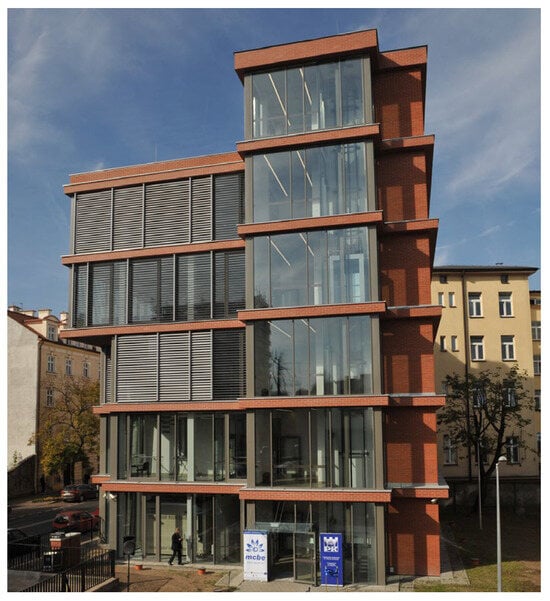
Figure 1.
View of the experimental MCBE building (Małopolska Center of Energy Efficient Building) [own source].
The MCBE building is equipped with advanced installations and a network of sensors and controllers enabling full automation and monitoring of building systems and experimental processes. It functions as a living laboratory for in situ testing of energy-efficient technologies. The facility was designed according to holistic nZEB principles, integrating a highly insulated building envelope, HVAC systems powered by renewable energy sources, and thermal energy storage managed by an advanced Building Management System (BMS).
The present study was carried out in an office waiting area on the fourth floor, with a floor area of 28.68 m2. It is enclosed on two sides by lightweight partition walls (12.5 cm thick, double-layer gypsum board on a steel frame with mineral wool insulation), with a glass partition separating it from an adjacent office and a fourth side consisting of an external window with blinds. During the experiment, the blinds in both the waiting area and adjacent rooms were closed, and temperatures in neighboring spaces were stabilized to minimize external influences. Additionally, the space was intentionally unoccupied to avoid interference with data collection.
The tested space is served by a ceiling-mounted FCU (Galletti EF95UILX, Bentivoglio, Italy) operating in a two-pipe system with heating and cooling functions and driven by an electronically commutated (EC) motor. Such motors allow for smooth adjustment of rotation speed and torque over a wide range, have reduced weight and dimensions, are energy efficient and low-noise, which allows them to be used in HVAC systems. The FCU is equipped with an electrothermal actuator on the return valve and mounted at a height of approximately 3.2 m above the floor. It is supplied by hot and cold-water energy storage tanks connected to heat pumps and conventional sources (district heating, gas boiler), with the option of supplementary heat from flat-plate and vacuum solar collectors. The operating mode (heating or cooling) depends on external conditions; during this study, the FCU operated in heating mode. Figure 2 and Figure 3 show the thermal energy storage system and the investigated FCU, respectively.

Figure 2.
Thermal energy storage tanks [own source].
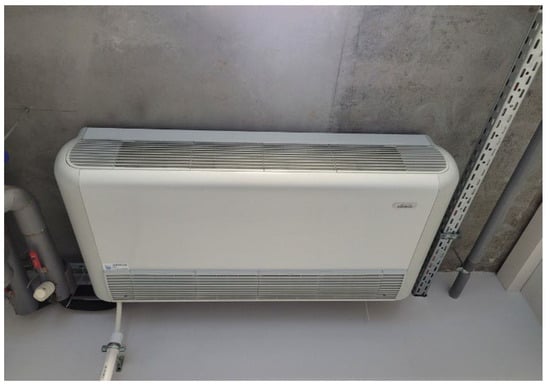
Figure 3.
The investigated ceiling-mounted fan coil unit (FCU) [own source].
2.2. Methodology
Thermal comfort parameters were monitored in the experimental room at three measurement points (A, B, and C) located at different distances from the FCU to capture spatial variations (see Figure 4). Sensors were positioned at a height of 1.7 m to represent the head level of a standing person, in accordance with EN ISO 7726:2002 []. The microclimatic parameters recorded included: air temperature (Ta), mean radiant temperature (Tr), relative humidity (RH), air velocity (Va). Additionally, to better capture the influence of the FCU on air velocity distribution, this parameter was also measured at heights of 0.1 m and 1.1 m, resulting in a grid of nine measurement points.
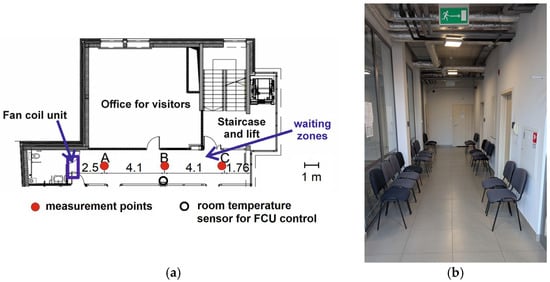
Figure 4.
The experimental waiting room: (a) floor plan showing the locations of indoor thermal comfort measurement points (A, B, and C); distances in meters; (b) illustrative photograph of the test room, with the ceiling-mounted FCU visible in the background—during the actual experiment, all participants remained standing in zones located near the measurement points [own source].
Measurements were performed using a microclimate meter EHA MM101 (Ekohigiena, Środa Śląska, Poland), compliant with EN ISO 7726:2002 Class C requirements [], and calibrated according to the manufacturer’s specifications. The metrological characteristics of the sensors are shown in Table 1. All data was collected at 10 min intervals.

Table 1.
Parameters of the sensors in the microclimate testing device [].
The thermal comfort conditions were evaluated using the predicted mean vote (PMV) and predicted percentage of dissatisfied (PPD) indices calculated according to ISO 7730:2006 []. The PMV model incorporates six input variables: air temperature, mean radiant temperature, air velocity, relative humidity, metabolic rate, and clothing insulation. While the first four parameters depend on the environmental conditions, the last two are human-related factors. The metabolic rate represents the amount of heat generated by the body through oxidation processes and is expressed as metabolic heat per unit of body surface area. Metabolism varies with activity level and is measured in units of “met” or W/m2 (1 met = 58.2 W/m2). The metabolic heat generated by a person depends on the type of activity being performed. For a sleeping person, it is 0.8 met, while for an athlete it can reach up to 10 met. The ISO 7730 standard describes metabolic values for different activities. The clo unit, meanwhile, is a measure of clothing insulation, which is required to maintain the average temperature of a person’s skin at about 33 °C while sitting in a room with an air temperature of 21 °C, relative humidity below 50%, and air movement of 0.1 m/s. This value assumes that a person’s metabolism is 1 met. For this study, a metabolic rate of 1.2 met (typical for standing and light activity in waiting areas) was adopted, a clothing insulation level of 0.7 clo was assumed, reflecting typical indoor work clothing [].
According to the PMV comfort scale developed by Fanger [] seven assessment points are defined where thermal equilibrium (comfort) conditions are marked as ‘0′ (see Table 2). The thermal comfort scale based on the ASHRAE system depends on the assessment of the thermal conditions in the room.

Table 2.
Thermal comfort scale [].
Based on the PMV model, the standard [] introduced room categories depending on the level of thermal comfort. The categories and their corresponding PMV and PPD ranges are presented in Table 3.

Table 3.
Design categories for mechanically heated and cooled buildings [].
To complement physical measurements, short, structured interviews were conducted with regular users of the building who were potentially exposed to discomfort related to air jets and temperature fluctuations. The interviews focused on: perceived thermal sensation (the standard ASHRAE 7-point thermal sensation scale: −3: cold, 0: neutral, +3: hot), perceived draught, and overall thermal satisfaction. A total of 18 volunteers participated in this study. They were recruited on site during the monitoring days using a convenience sampling approach and consisted mainly of students and laboratory staff working in the building. The sample included 10 women and 8 men, aged 19–53 years, all of whom declared good general health on the day of the survey. Their clothing corresponded to underwear, shirt, trousers, socks and shoes, or thermally equivalent garments, which is consistent with the clothing insulation value of clo = 0.7 assumed in the PMV model. The activity level was typical of standing, i.e., approximately 1.2 met. Participants answered the questions shortly after spending at least thirty minutes in the waiting area, being exposed to both phases of FCU operation: the active heating phase and the standby/natural room cooling phase. The survey distribution was aligned with the FCU operation cycles, allowing participants to provide their assessments during each phase. The responses were aggregated and converted to an equivalent dissatisfaction indicator and compared with the modelled PPD values calculated from the recorded microclimate parameters. Statistical analyses were conducted using the STATISTICA software package (v. 13.3). Given the limited sample size, the survey should be regarded as a pilot assessment supporting the interpretation of the PMV/PPD results rather than a full-scale questionnaire study.
The experiment involved two FCU operating modes. In the OFF mode, the FCU was completely disabled, resulting in no forced airflow; heating of the waiting area occurred only through the ventilation air supply and heat transfer from adjacent rooms. In the ON mode, the FCU operated in heating mode to maintain a constant room temperature of 22 °C, using hot water at 50–55 °C supplied from the thermal energy storage system. The unit employed a basic single-speed on/off temperature control at full capacity: it remained inactive when the room temperature was at or near the setpoint (minimal control deviation) and switched to maximum output only when reheating was required (increased control deviation). The operating modes and experimental schedule are summarized in Table 4.

Table 4.
Operating schedule of the FCU.
In the ON mode, the FCU was controlled via the master BMS system, which enables both the configuration of control logic and the adjustment of operating parameters, in combination with the iBASe-FCU-A field controller (ZDANIA, Kraków, Poland). The field controller is designed to maintain thermal comfort in rooms equipped with FCUs as part of a distributed control system. Based on the target temperature (setpoint) and real-time room temperature data, it controls the FCU system components—the fan drive for air circulation and the heating medium valve actuator—and signals to the BMS when operation of the building’s distribution circuit pump is required, thereby stabilizing the indoor temperature at the desired level. Information about the real-time room temperature is provided by an internal sensor of the wall-mounted room controller (Figure 5), installed on a column approximately 1.4 m above the floor, near microclimate sensor B (see Figure 4).
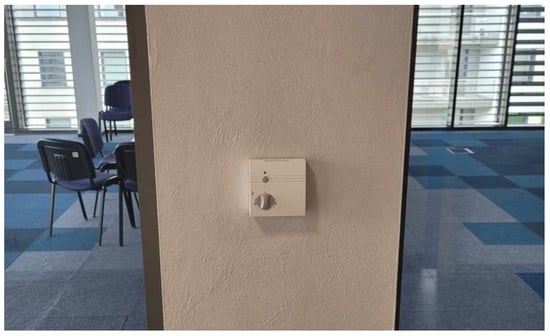
Figure 5.
Wall-mounted room controller with internal temperature sensor [own source].
In both ON and OFF modes, the room was ventilated with a constant airflow of 75 m3/h and a stabilized supply air temperature of 20 °C. The local outdoor weather conditions were typical for late winter in the urban area of Kraków in recent years. Based on the records from the weather station installed on the eastern façade of the building (facing the glazed surface of the waiting area), the outdoor temperature ranged approximately from −3 °C during night-time to +7 °C during daytime, with mean daily values close to +3 °C. Wind speed did not exceed 3.8 m/s (light breeze), and solar irradiance reached up to 430 W/m2, with peak levels observed in the late-morning to early-afternoon hours. Prior to the measurement intervals, indoor conditions were stabilised for several days according to the FCU operating mode assigned to each experimental phase.
This study focused on a single waiting area and a short monitoring period (two days). While this was sufficient to capture the short-term effect of FCU operation, it does not fully reflect the variability in weather conditions, seasonal changes, or different occupancy scenarios. The subjective comfort assessment was limited to short interviews rather than a full thermal sensation vote (TSV) campaign. These limitations are addressed in the conclusions as a basis for future research directions.
3. Results
3.1. Fan Coil Unit OFF Mode
In the OFF mode, the FCU was turned off. Figure 6, Figure 7, Figure 8 and Figure 9 show, respectively, temperatures, air velocities, PMV and PPD indices recorded at points A, B, C, at 1.7 m level.
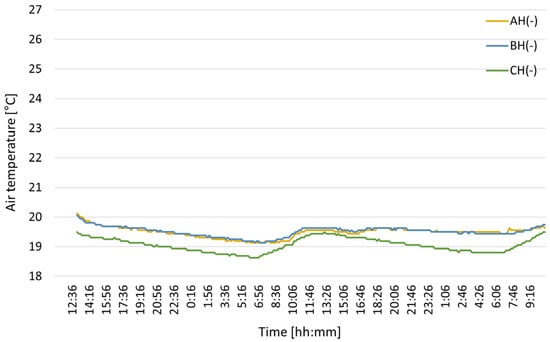
Figure 6.
Temperatures recorded at points A, B, C at 1.7 m level, in the OFF mode.
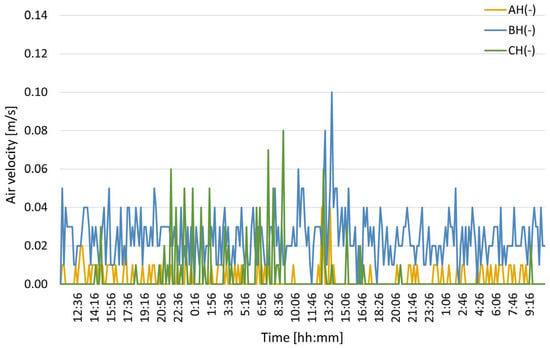
Figure 7.
Air velocities recorded at points A, B, C at 1.7 m level, in the OFF mode.
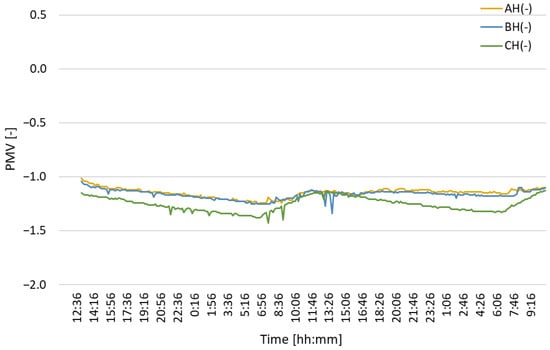
Figure 8.
Predicted mean vote (PMV) indices recorded at points A, B, C, at 1.7 m level, in the OFF mode.
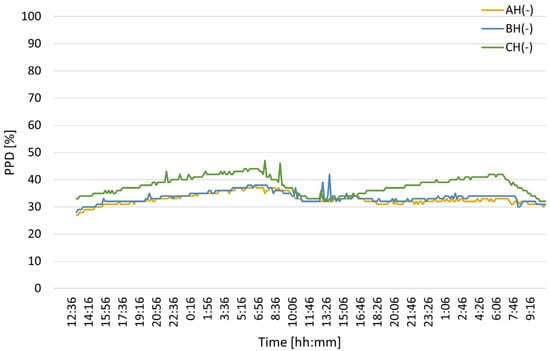
Figure 9.
Predicted percentage of dissatisfied (PPD) indices recorded at points A, B, C at 1.7 m level, in the OFF mode.
In the OFF mode, due to the absence of active heating, the air temperature generally did not exceed 20 °C. With no forced airflow from the FCU, the air velocity remained below 0.1 m/s at all measurement points. However, the air velocities are not constant and differ in values at measurement points A, B, and C. The thermal comfort index PMV ranged between −1.43 < PMV < −1.01, indicating a thermal state between “cool” and “cold” (according to ISO 7730 []). The PPD index indicates that there will be between 27% and 47% of dissatisfied people with the prevailing conditions. Therefore, the room conditions are outside the classification limits of indoor environment categories defined in EN 16798 []. The most significant deviations from optimal conditions, confirmed by the largest number of dissatisfied is attributed to point C, located closest to the glass facade. This location has the lowest recorded temperatures, too low to provide thermal comfort for occupants. The results characterize the condition of an unheated room in which the thermal environment is shaped primarily by passive factors—the supply of tempered ventilation air, heat exchange with adjacent rooms in both horizontal and vertical planes, and dynamic external atmospheric influences transmitted through the building envelope. This configuration leads to uneven temperature distribution and locally reduced comfort, particularly in zones exposed to the façade, where thermal losses are most pronounced.
3.2. Fan Coil Unit ON Mode
In the ON mode, the FCU’s fan operated at 100% capacity during periods of heating demand in the room. Figure 10, Figure 11, Figure 12 and Figure 13 show, respectively, temperatures, air velocities, PMV and PPD indices recorded at points A, B, C, at 1.7 m level in the ON mode.
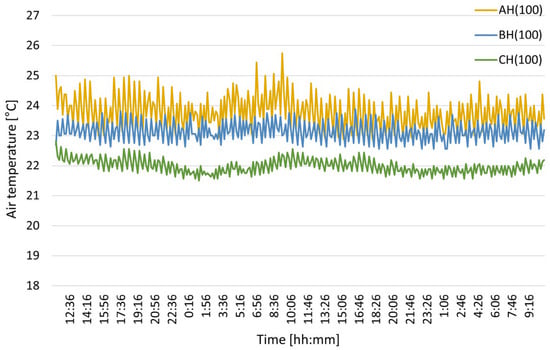
Figure 10.
Temperatures recorded at points A, B, C, at 1.7 m level, in the ON mode.
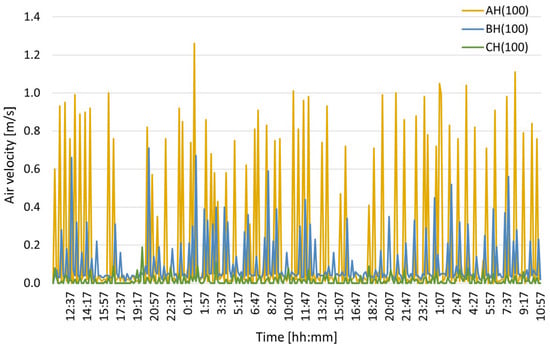
Figure 11.
Air velocities recorded at points A, B, C, at 1.7 m level, in the ON mode.
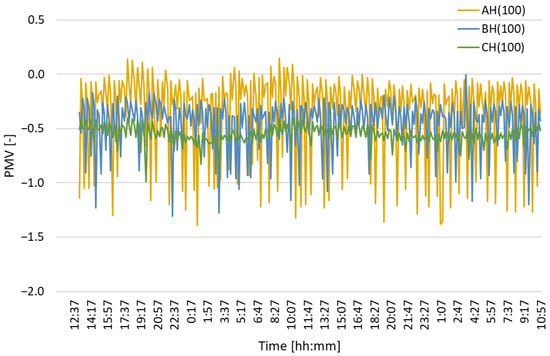
Figure 12.
PMV indices recorded at points A, B, C, at 1.7 m level, in the ON mode.
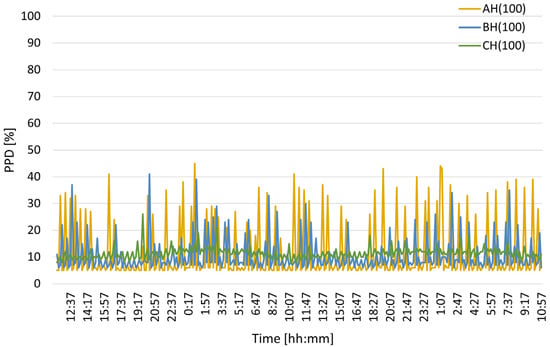
Figure 13.
PPD indices recorded at points A, B, C, at 1.7 m level, in the ON mode.
In the ON mode, an increase in average air temperature was observed with increasing distance from the window and decreasing distance to the FCU. This pattern reflects the combined influence of moving away from the cooling effect of the glazed façade and approaching the main heat source. The temperature profiles shown in Figure 10 clearly illustrate the principle of the applied automatic temperature regulation method using the FCU in ON mode. Alternating heating phases—resulting from the unit’s operation—and subsequent natural cooling of the room are clearly visible. The associated temperature fluctuations were most pronounced near the FCU, where the unit’s periodic operation produced the strongest transient heating effect. Based on the 1 min BMS data, the FCU was active for 22.4% of the analyzed period.
The control system was set to maintain a target temperature of 22 °C, measured by the wall-mounted sensor, which—as shown in Figure 10—approximately corresponded to the average temperature recorded by the microclimate sensors at point C. However, at points A and B, the measured temperatures significantly exceeded this value. At point A, temporary temperature peaks above 25 °C indicated that the FCU control logic, driven by data from the wall-mounted sensor, led to local overheating. At point B, located closest to the wall-mounted sensor, the average temperature was about 1 °C higher than the setpoint. This discrepancy was likely caused, among other factors, by the thermal influence of the column on which the sensor was mounted and by the lower accuracy class of the wall sensor compared to the precision microclimate sensors. In this case, applying a downward offset of approximately 1 °C to the wall sensor reading would allow the control system to better maintain the desired average room temperature.
Air velocity measurements revealed substantial spatial variation: at point A, located directly beneath the FCU, peak velocities reached 1.26 m/s, while at the most distant point, values did not exceed 0.19 m/s. The authors are aware of the limitations of the applicability of the PMV model to air velocity of 1 m/s. In this study, higher readings represented only 1.8% of all data and did not significantly affect the overall interpretation.
The thermal comfort index (PMV) ranged from −1.39 to +0.15. Proximity to the FCU was associated with greater variability in PMV, resulting from intensified air movement and the intermittent heating operation of the unit. The most stable comfort conditions occurred at point C, where the FCU’s direct influence was minimal; however, its location near the glazed façade caused a noticeable cooling effect from external conditions. At this point, the degree of dissatisfaction expressed by the PPD index ranged from 6% to 41%. The highest PMV variability occurred at point A, closest to the FCU, where the comfort category ranged from I to values exceeding the allowable limits for category IV (Table 3), depending on fan operation. The PPD index for this point ranged from 5% to 45%. Such pronounced PMV fluctuations—up to 1.0–1.2 units within 10 min—may lead to additional discomfort for individuals remaining in this zone for extended periods.
3.3. Analysis of Air Velocity Distribution
To visualize the vertical and longitudinal variation in air velocity in the waiting area for both FCU operating modes (OFF and ON with the FCU in operation), distribution of average air velocity was generated based on data from nine measurement points (see Figure 14).

Figure 14.
Comparison of the spatial distribution of mean air velocities in the waiting area for the OFF mode and the ON mode (FCU active phase only).
When the FCU was switched off, the results indicated a relatively uniform indoor environment, with air velocity remaining at a low and stable level—generally below 0.05 m/s. Slightly higher mean air velocities than at the other zones were observed in the central part of the waiting area (point B), most likely due to the nearby termination of the ventilation supply duct. The vertical gradient of air velocity was also relatively small, indicating stable air conditions without noticeable stratification.
In contrast, in the ON mode with the FCU operating, a significant increase in air velocity was observed across all zones of the waiting area. The spatial distribution became less uniform, with a distinct weakening of the airflow toward the far end of the area (point C). A pronounced vertical gradient appeared at point A, with the highest mean air velocity recorded at 1.7 m and a marked decrease toward the floor. This pattern reflects the directional discharge of the airflow from the FCU outlet and local mixing effects. At point B, air velocities increased substantially at all measured heights compared to the OFF mode, which can be attributed to partial dispersion of the air jet at this distance. At point C, air velocities were the lowest, resulting from the significant attenuation of the air stream at that distance from the unit.
The analysis of air velocity distribution under both operating conditions shows that the operating FCU significantly modifies local airflow patterns within the waiting area. While the OFF mode provided stable and uniform conditions, each activation of the FCU in ON mode generated distinct air jets and vertical gradients, particularly in the vicinity of the unit. These intensified airflows, although beneficial for heat distribution, may simultaneously cause localized draft sensations and increase variability in perceived thermal comfort.
3.4. Comparison of Modelled Thermal Comfort in Both FCU Operating Modes
The average values of the PMV index were calculated for three measurement points (A, B, and C) in the waiting area, for two FCU modes: switched off (OFF) and operating at full capacity in heating mode (ON) (see Figure 15).
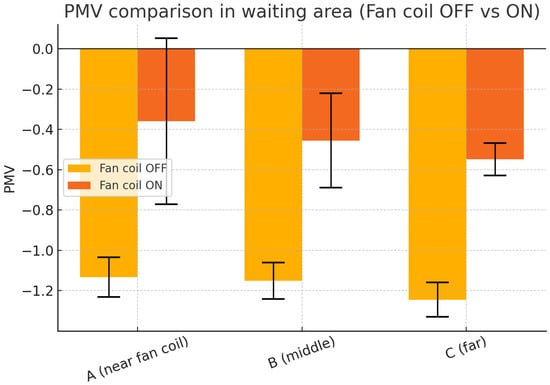
Figure 15.
Mean PMV values and standard deviations at each measurement point for both operating modes.
The results show that in the ON mode, the FCU increased the average PMV values at all measurement points, indicating a shift toward warmer thermal perception compared to the OFF mode. However, the results also revealed significant spatial differences. In particular, point A (located closest to the FCU) exhibited the highest variability (standard deviation ±0.41), confirming unstable thermal conditions due to the intermittent on/off operation and the impact of local air jet. These findings suggest that while the FCU improves average thermal comfort, the generated local air jet can negatively influence comfort stability, especially in zones near the FCU.
In addition to PMV, the PPD index was determined to quantify the proportion of occupants potentially dissatisfied with the thermal environment under different operating conditions of the FCU. Figure 16 compares the PPD values at three measurement points (A, B, C) in the waiting area, for both operating modes.
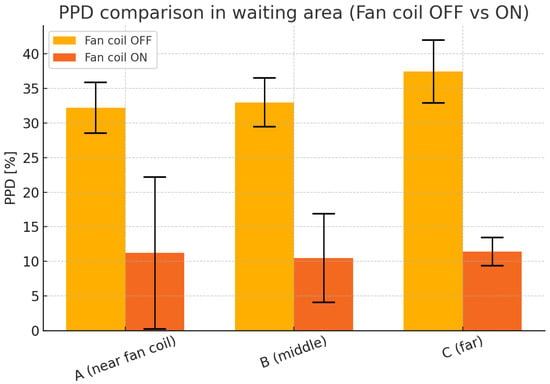
Figure 16.
Mean PPD values and standard deviations at each measurement point for both operating modes.
The results show a significant decrease in PPD values when the FCU was operating—from 32–37% in the OFF mode to around 10–11% in the ON mode. However, point A (located closest to the FCU) exhibited high variability (SD ± 11%), indicating the influence of unstable local air velocity (periodic air jet) and the resulting transient comfort conditions, despite the overall improvement in temperature.
3.5. Comparison of Modelled and Surveyed Dissatisfaction
To validate the objective comfort indices (PMV and PPD) and account for subjective perceptions, a short questionnaire survey was conducted among occupants present in the waiting area in the ON mode. Table 5 summarizes the results. The comparison between PPD values and questionnaire is shown in Figure 17.

Table 5.
Results of questionnaire (n = 18).
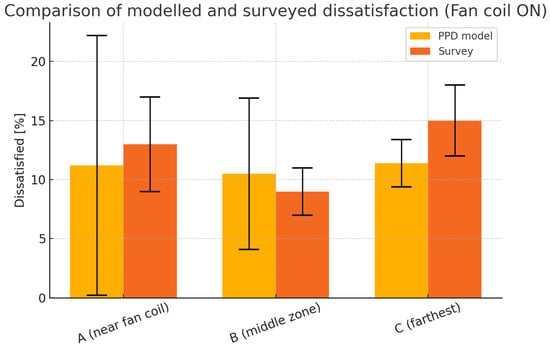
Figure 17.
Comparison between PPD values and questionnaire results (n = 18) in the ON mode, including mean values and standard deviations.
The modelled PPD values showed much higher variability, particularly in point A, where the intermittent on/off operation of the FCU caused rapid changes in local thermal conditions and air velocity patterns. In contrast, the survey responses, which reflect the average occupant experience over thirty minutes of exposure, indicated slightly higher overall dissatisfaction and smaller variability. This suggests that instantaneous model-based comfort indices may underestimate discomfort in transient air velocity conditions, whereas subjective surveys smooth out short-term fluctuations and provide a more realistic assessment of perceived comfort. The combined use of objective modelling and subjective feedback allows a better understanding of both the dynamic effects of FCU operation and the overall occupant experience, highlighting that the middle zone (point B) offers the most stable and comfortable conditions.
4. Discussion
Based only on the instantaneous PMV waveforms in the ON mode (with the FCU operating at 100% capacity according to demand) it is difficult to clearly identify the measurement point where the highest comfort level was achieved (see Figure 12). However, during periods when the FCU was inactive, the results indicate that thermal comfort was highest at point A, lower at point B, and lowest at point C. This pattern reflects the temperature distribution at these points, with uniformly low air velocity. In contrast, when the FCU was blowing air, the order reversed–comfort was highest at point C, lower at point B, and lowest at point A. This was caused by the strong air jet from the FCU, which intensified the sensation of coolness. The effect gradually weakened with increasing distance from the unit. unit.
To assess the overall comfort conditions in the waiting area, the PMV and PPD indices were statistically analyzed for different measurement points in both FCU operating modes, complemented by the results of short questionnaire surveys on subjective thermal perceptions. The results show that although the temperature increased during FCU operation, perceived thermal comfort was not uniformly improved. Near the FCU (point A), occupants reported discomfort primarily due to local air jet (draught sensation), while at the farthest point C cooler conditions persisted. The middle zone (point B) provided the most balanced and stable comfort conditions.
These results confirm that while the FCU improves the overall thermal comfort index, local air jet can cause fluctuations in occupant comfort, which is particularly relevant in semi-transient spaces such as waiting areas. The findings emphasize that although FCUs enable rapid thermal conditioning through warm-air delivery, they may simultaneously negatively affect perceived comfort and should therefore be operated under control strategies designed to minimize draft sensation. A practical approach involves adjusting fan speed according to occupancy schedules, maintaining the lowest airflow rate that still ensures adequate heating capacity and effective air mixing for heat distribution within the room. Attention should also be given to the initial phase of FCU operation, when the fan begins circulating room air through a heat exchanger that has not yet reached its target temperature–due to the control system characteristics, actuator response delays, and the time required for the heating medium to reach the unit. As a result, occupants may experience an initial blast of unheated air. This effect can be mitigated by preheating the heat exchanger prior to fan operation and by implementing a gradual fan speed ramp-up strategy. Moreover, incorporating occupancy-sensor-based control can further enhance system performance by adapting operation to real-time usage patterns. For instance, preheating can be triggered before expected occupancy periods, whereas setback temperature settings during unoccupied hours can contribute to energy savings. In thermally non-uniform environments, it is essential that control feedback is based on temperature readings from a representative location within the room. The application of multi-point temperature sensing for feedback control can further improve regulation accuracy and overall comfort stability.
The analysis of instantaneous spatial comfort distributions—supported by statistical evaluation of comfort indices as a function of distance from the FCU—confirmed a systematic comfort gradient along the analyzed waiting area in both FCU operating modes. In the ON mode, during periods when the FCU was active, the model-based PPD values exhibited high variability, particularly near the FCU, due to the automatic on/off control that caused rapid fluctuations in local air velocity and temperature. In contrast, survey responses showed slightly higher overall dissatisfaction and smaller variability, reflecting the averaging effect of occupant perception over time.
These findings demonstrate the limitations of simple on/off control strategies for FCUs in waiting areas. Intermittent operation not only introduces transient discomfort when the FCU switches on (perceived as a sudden draught) but also fails to ensure a uniform temperature distribution. To address these issues, it is recommended to:
- operate the FCU at lower but continuous fan speeds that are still sufficient to provide the required heating capacity and maintain effective air mixing and heat distribution within the room,
- integrate occupancy-based control strategies, such as reducing fan speed in response to occupancy or activating room preheating before expected occupancy periods,
- in thermally non-uniform environments, consider implementing control based on multi-point temperature measurements,
- implement heat exchanger preheating prior to fan activation and gradual fan speed ramp-up, to prevent unheated air drafts during system start-up.
Such measures would reduce local discomfort caused by draughts and noise, while improving perceived comfort and reducing peak power demand of the fan drive. However, these solutions must be adapted to the specific characteristics of the space, including the location of the FCU, heating demand, and local climatic conditions. Future work should focus on detailed analysis of short-term comfort changes during the start-up phase and the effectiveness of advanced FCU control strategies, including preheating of the heat exchanger before fan activation, use gradual fan speed ramp-up to avoid blasts of unheated air at start-up, as well as combining modelled comfort indices with real user feedback.
The results of this study confirm that even in energy-efficient office buildings, terminal HVAC devices such as FCUs may negatively affect thermal comfort in localized zones. While the FCU increased the average temperature in the waiting area, its operation also introduced intensified air movement, shifting perceived thermal sensation toward cooler values in the immediate vicinity of the unit. This effect was confirmed by both model-based comfort indices (PMV, PPD) and user feedback from surveys.
A key finding is that instantaneous model calculations of PPD exhibited high variability, especially near the FCU, due to the intermittent on/off operation of the device. In contrast, occupant surveys showed slightly higher overall dissatisfaction and smaller variability, indicating that short-term airflow fluctuations are less impactful when averaged over typical waiting times. These results suggest that while model-based indices are useful for identifying potential problem areas, subjective surveys provide essential insight into perceived comfort stability. These findings are consistent with earlier studies highlighting the importance of local air velocity patterns and their influence on occupant comfort. Fanger and Christensen [] demonstrated that occupants are particularly sensitive to draughts in environments with moderate activity levels, and that local air velocity often dominates comfort perception even when average room temperature is acceptable. Similarly, Hou et al. [] emphasized that local discomfort, especially in transient or transitional zones, is one of the main challenges in implementing energy-saving HVAC strategies.
In the context of nZEB buildings, Piasecki [] and other researchers [,,] noted that achieving energy efficiency while ensuring indoor environmental quality remains a complex task. Much of the existing research focuses on permanently occupied office spaces or residential rooms [,], whereas semi-transient spaces such as waiting areas are often overlooked in design guidelines. The present study extends current knowledge by providing field data from a real nZEB office building, combining objective comfort indices (PMV, PPD) and spatial analysis methods that account for the distance from the FCU with direct user feedback.
The results also support the recommendations found in previous research [,], which suggest adopting advanced FCU control strategies to mitigate start-up discomfort and draft sensations. Gradual fan speed ramp-up, preheating of heat exchangers before fan activation, and integration of occupancy-based control strategies have the potential to reduce discomfort events while maintaining energy efficiency. Recent studies on HVAC control approaches highlight that data-driven and adaptive control strategies—including reinforcement learning, fuzzy logic, and artificial neural networks—are increasingly viewed as viable alternatives to conventional rule-based and Model Predictive Control (MPC) strategies. Moreover, MPC enhanced with Large Language Models (LLMs), as well as constrained reinforcement learning frameworks, have demonstrated the potential to optimize HVAC operation with higher comfort compliance and reduced energy consumption. Taken together, these findings suggest that future FCU management—particularly in dynamically occupied spaces such as waiting areas—could benefit from integrating such advanced decision-making mechanisms into real-world building automation systems [,,,].
Nevertheless, this study has limitations. Only one waiting area was analyzed, the subjective assessment was limited to short interviews, and the monitoring period was relatively short. Despite these limitations, the consistency between our findings, subjective feedback, and published literature strengthens the conclusion that terminal HVAC units such as FCUs, if not properly controlled, can negatively influence perceived comfort even in spaces intended for short-term occupancy.
5. Conclusions
This study analyzed the influence of a ceiling-mounted FCU operating in heating mode on thermal comfort in an office waiting area of a nearly zero-energy building (nZEB). Two distinct operating modes were considered: the fan coil (FCU) switched off, and single-speed on/off temperature control at full capacity. The research combined objective microclimate measurements with comfort indices (PMV, PPD) and a short occupant survey.
An innovative aspect of this study is its focus on semi-transient waiting areas—a type of space rarely analyzed in previous research—and the evaluation of localized comfort effects within such environments. The results revealed that while FCU operation increased the average temperature, it also generated air jet patterns that locally reduced comfort near the FCU. The calculated PPD showed high temporal variability in this zone due to the on/off control strategy, whereas survey responses indicated higher and more stable dissatisfaction levels, highlighting the importance of combining model-based indices with occupant feedback.
Another significant finding concerns transient discomfort during start-up phases, where a blast of unheated air was perceived due to heating system delays. These results demonstrate that simple on/off FCU control is insufficient to ensure uniform and stable comfort, even in spaces intended for short-term occupancy.
Practical implications include the following recommendations:
- Operate FCUs at reduced but continuous fan speeds;
- Implement heat exchanger preheating and gradual fan speed ramp-up to prevent start-up discomfort;
- Integrate occupancy-based control strategies and consider control based on multi-point temperature measurements.
Future research should extend these analyses to year-round conditions to reflect the variability in weather and seasonal changes. Additionally, a more in-depth investigation of vertical comfort profiles at different body heights—for both standing and seated occupants—would be valuable, preferably supported by CFD analyses and more detailed occupant surveys. It would also be beneficial to broaden the scope to include multiple waiting areas and other semi-transient spaces. Furthermore, future studies may evaluate advanced intelligent control strategies that integrate occupancy detection, multipoint temperature measurements, and air velocity modulation. These efforts would support improved comfort in semi-transient spaces while maintaining the energy efficiency objectives of nZEB buildings.
Author Contributions
Conceptualization, M.F.-C. and M.D.; methodology, M.F.-C., A.K.-K. and M.D.; software, M.F.-C. and M.D.; validation, M.F.-C., A.B.-C., M.D. and A.K.-K.; formal analysis, M.F.-C., A.B.-C., M.D. and A.K.-K.; investigation, M.F.-C., A.B.-C. and M.D.; resources, M.F.-C., A.B.-C. and M.D.; data curation, M.F.-C., and A.K.-K.; writing—original draft preparation, M.F.-C., A.B.-C., M.D., A.K.-K., A.S. and M.C.; writing—review and editing, M.F.-C., M.D. and A.K.-K.; visualization, M.F.-C., M.D., A.K.-K. and A.S.; supervision, M.F.-C. and A.K.-K.; project administration, A.B.-C. and M.D.; funding acquisition M.F.-C. All authors have read and agreed to the published version of the manuscript.
Funding
This research received no external funding.
Data Availability Statement
The datasets presented in this article are not readily available because they are part of a broader ongoing study. Requests to access the datasets should be directed to the corresponding author.
Conflicts of Interest
The authors declare no conflicts of interest.
Abbreviations
The following abbreviations are used in this manuscript:
| FCU | fan coil unit |
| nZEB | nearly zero-energy building; standard applicable in the European Union |
| HVAC | heating, ventilation and air-conditioning system |
| PMV | predicted mean vote |
| PPD | predicted percentage of dissatisfied |
| MCBE | Małopolska Center of Energy Efficient Building |
| BMS | Building management system |
References
- BPIE–Buildings Performance Institute Europe. Nearly Zero: A Review of EU Member State Implementation of New Build Requirements. Available online: https://www.bpie.eu/publication/nearly-zero-a-review-of-eu-member-state-implementation-of-new-build-requirements/ (accessed on 22 August 2024).
- Directive 2002/91–EN–EUR-Lex. Available online: https://eur-lex.europa.eu/legal-content/en/ALL/?uri=CELEX%3A32002L0091 (accessed on 22 August 2024).
- Directive 2010/31–EN–EUR-Lex. Available online: https://eur-lex.europa.eu/eli/dir/2010/31/oj (accessed on 22 August 2024).
- Directive 2018/844–EN–EUR-Lex. Available online: https://eur-lex.europa.eu/eli/dir/2018/844/oj (accessed on 22 August 2024).
- Directive EU–2024/1275–EN–EUR-Lex. Available online: https://eur-lex.europa.eu/legal-content/EN/TXT/?uri=CELEX%3A32024L1275 (accessed on 22 August 2024).
- Fedorczak-Cisak, M.; Furtak, M. Energy Efficient Building in the Context of Development Strategy of Malopolska. In Proceedings of the CESB 2013 PRAGUE–Central Europe Towards Sustainable Building 2013: Sustainable Building and Refurbishment for Next Generations, Prague, Czech Republic, 26–28 June 2013. [Google Scholar]
- Fanger, P.O. Thermal Comfort: Analysis and Applications in Environmental Engineering; McGraw-Hill: Columbus, OH, USA, 1972; ISBN 9780070199156. [Google Scholar]
- van Hoof, J.; Mazej, M.; Hensen, J.L.M. Thermal Comfort: Research and Practice. Front Biosci. 2010, 15, 765–788. [Google Scholar] [CrossRef]
- Piasecki, M.; Radziszewska-Zielina, E.; Czerski, P.; Fedorczak-Cisak, M.; Zielina, M.; Krzyściak, P.; Kwaśniewska-Sip, P.; Grześkowiak, W. Implementation of the Indoor Environmental Quality (IEQ) Model for the Assessment of a Retrofitted Historical Masonry Building. Energies 2020, 13, 6051. [Google Scholar] [CrossRef]
- Piasecki, M. Practical Implementation of the Indoor Environmental Quality Model for the Assessment of Nearly Zero Energy Single-Family Building. Buildings 2019, 9, 214. [Google Scholar] [CrossRef]
- Kisilewicz, T. Passive Control of Indoor Climate Conditions in Low Energy Buildings. Energy Procedia 2015, 78, 49–54. [Google Scholar] [CrossRef]
- Nowak, K.; Rojewska-Warchał, M. The Type and Size of Glazing versus Thermal Comfort in Office Spaces. In Budownictwo i Fizyka Budowli; Kisilewicz, T., Ed.; Wydawnictwo PK: Kraków, Poland, 2021; pp. 1–85. ISBN 978-83-66531-70-3. (In Polish) [Google Scholar]
- Dudzińska, A.; Kisilewicz, T. Alternative Ways of Cooling a Passive School Building in Order to Maintain Thermal Comfort in Summer. Energies 2020, 14, 70. [Google Scholar] [CrossRef]
- Fedorczak-Cisak, M.; Nowak, K.; Furtak, M. Analysis of the Effect of Using External Venetian Blinds on the Thermal Comfort of Users of Highly Glazed Office Rooms in a Transition Season of Temperate Climate—Case Study. Energies 2019, 13, 81. [Google Scholar] [CrossRef]
- Melikov, A.; Nielsen, J. Local Thermal Discomfort Due to Draft and Vertical Temperature Difference in Rooms with Displacement Ventilation. ASHRAE Trans. 1989, 95, 1050–1057. [Google Scholar]
- Fanger, P.O.; Christensen, N.K. Perception of Draught in Ventilated Spaces. Ergonomics 1986, 29, 215–235. [Google Scholar] [CrossRef] [PubMed]
- Akyildiz, A.T.; Kowalska-Koczwara, A.; Hojdys, Ł. Seismic Protection of RC Buildings by Polymeric Infill Wall-Frame Interface. Polymers 2021, 13, 1577. [Google Scholar] [CrossRef]
- Nowak-Dzieszko, K. Wpływ Stężenia Pyłów PM10 Oraz PM2.5 w Środowisku Zewnętrznym Na Jakość Powietrza Wewnątrz Pomieszczeń [The Influence of PM10 and PM2.5 Concentrations in the Outdoor Environment on Indoor Air Quality, in Polish]. Mater. Bud. 2024, 1, 37–41. [Google Scholar] [CrossRef]
- Fedorczak-Cisak, M.; Radziszewska-Zielina, E.; Nowak-Ocłoń, M.; Biskupski, J.; Jastrzębski, P.; Kotowicz, A.; Varbanov, P.S.; Klemeš, J.J. A Concept to Maximise Energy Self-Sufficiency of the Housing Stock in Central Europe Based on Renewable Resources and Efficiency Improvement. Energy 2023, 278, 127812. [Google Scholar] [CrossRef]
- Hou, Y.; Vidu, R.; Stroeve, P. Solar Energy Storage Methods. Ind. Eng. Chem. Res. 2011, 50, 8954–8964. [Google Scholar] [CrossRef]
- Marks-Bielska, R.; Bielski, S.; Pik, K.; Kurowska, K. The Importance of Renewable Energy Sources in Poland’s Energy Mix. Energies 2020, 13, 4624. [Google Scholar] [CrossRef]
- Rafał, K. Construction of Hybrid Energy Storage Systems–Technical Aspects and Safety. Mater. Bud. 2023, 1, 49–51. (In Polish) [Google Scholar] [CrossRef]
- Kisilewicz, T. Computer Simulation in Solar Architecture Design. Archit. Eng. Des. Manag. 2007, 3, 106–123. [Google Scholar] [CrossRef]
- Dudzik, M.; Romanska-Zapala, A.; Bomberg, M. A Neural Network for Monitoring and Characterization of Buildings with Environmental Quality Management, Part 1: Verification under Steady State Conditions. Energies 2020, 13, 3469. [Google Scholar] [CrossRef]
- Zhu, X.; Li, H. Heating, Ventilation, and Air Conditioning (HVAC) Temperature and Humidity Control Optimization Based on Large Language Models (LLMs). Energies 2025, 18, 1813. [Google Scholar] [CrossRef]
- Esmaeili, M.; Hammes, S.; Tosatto, S.; Geisler-Moroder, D.; Zech, P. Safe Reinforcement Learning for Buildings: Minimizing Energy Use While Maximizing Occupant Comfort. Energies 2025, 18, 5313. [Google Scholar] [CrossRef]
- Michailidis, P.; Michailidis, I.; Vamvakas, D.; Kosmatopoulos, E. Model-Free HVAC Control in Buildings: A Review. Energies 2023, 16, 7124. [Google Scholar] [CrossRef]
- Luo, Y.; Zhang, L.; Bozlar, M.; Liu, Z.; Guo, H.; Meggers, F. Active Building Envelope Systems toward Renewable and Sustainable Energy. Renew. Sustain. Energy Rev. 2019, 104, 470–491. [Google Scholar] [CrossRef]
- Li, W.; Nurdin, H.; Swan, P. Control-Oriented Fan Coil Unit Modeling for Room Dynamics Considering Dehumidifying Cooling Conditions and Indoor Air Quality. Energy Convers. Manag. X 2023, 20, 100476. [Google Scholar] [CrossRef]
- Ye, J.; Liu, X.; Xu, L.; Ni, L. Experimental Study on the Heating and Humidifying Performance of Fan Coil Units with Humidification Modules in Severe Cold Regions. Energy Build 2022, 276, 112500. [Google Scholar] [CrossRef]
- Aynur, T.N. Variable Refrigerant Flow Systems: A Review. Energy Build. 2010, 42, 1106–1112. [Google Scholar] [CrossRef]
- Biskupski, J. Intelligent Ventilation System with Heat Recovery. Rynek Instal. 2009, 4, 61–62. (In Polish) [Google Scholar]
- Biskupski, J. Intelligent Residential Building: A Case Study Based on the Galia House. Rynek Instal. 2009, 1–2, 43–47. (In Polish) [Google Scholar]
- Chen, Y.; Lin, G.; Chen, Z.; Wen, J.; Granderson, J. A Simulation-Based Evaluation of Fan Coil Unit Fault Effects. Energy Build. 2022, 263, 112041. [Google Scholar] [CrossRef]
- Lee, J.; Cha, S.H.; Hong, T.; Koo, C. Empirical Investigation of Occupant-Centric Thermal Comfort in Hotel Guestrooms. Renew. Sustain. Energy Rev. 2024, 189, 114046. [Google Scholar] [CrossRef]
- Dezfouli, M.M.S.; Dehghani-Sanij, A.R.; Kadir, K.; Suhairi, R.; Rostami, S.; Sopian, K. Is a Fan Coil Unit (FCU) an Efficient Cooling System for Net-Zero Energy Buildings (NZEBs) in Tropical Regions? An Experimental Study on Thermal Comfort and Energy Performance of an FCU. Results Eng. 2023, 20, 101524. [Google Scholar] [CrossRef]
- Chen, C.; An, J.; Wang, C.; Duan, X.; Lu, S.; Che, H.; Qi, M.; Yan, D. Deep Reinforcement Learning-Based Joint Optimization Control of Indoor Temperature and Relative Humidity in Office Buildings. Buildings 2023, 13, 438. [Google Scholar] [CrossRef]
- Winiarski, D.W.; Jiang, W.; Halverson, M.A. Review of Pre- and Post-1980 Buildings in CBECS—HVAC Equipment; Pacific Northwest National Laboratory (PNNL): Richland, WA, USA, 2006. [Google Scholar] [CrossRef]
- Dong, Z.; Boyi, Q.; Pengfei, L.; Zhoujian, A. Comprehensive Evaluation and Optimization of Rural Space Heating Modes in Cold Areas Based on PMV-PPD. Energy Build. 2021, 246, 111120. [Google Scholar] [CrossRef]
- Kiil, M.; Simson, R.; Thalfeldt, M.; Kurnitski, J. A Comparative Study on Cooling Period Thermal Comfort Assessment in Modern Open Office Landscape in Estonia. Atmosphere 2020, 11, 127. [Google Scholar] [CrossRef]
- Võsa, K.-V.; Ferrantelli, A.; Kurnitski, J. Cooling Thermal Comfort and Efficiency Parameters of Ceiling Panels, Underfloor Cooling, Fan-Assisted Radiators, and Fan Coil. Energies 2022, 15, 4156. [Google Scholar] [CrossRef]
- Jahanbin, A. Efficacy of Coupling Heat Recovery Ventilation and Fan Coil Systems in Improving the Indoor Air Quality and Thermal Comfort Condition. Energy Built Environ. 2022, 3, 478–495. [Google Scholar] [CrossRef]
- Semprini, G.; Jahanbin, A.; Pulvirenti, B.; Guidorzi, P. Evaluation of Thermal Comfort inside an Office Equipped with a Fan Coil HVAC System: A CFD Approach. Future Cities Environ. 2019, 5, 1–10. [Google Scholar] [CrossRef]
- Lamsal, P.; Bajracharya, S.B.; Rijal, H.B. A Review on Adaptive Thermal Comfort of Office Building for Energy-Saving Building Design. Energies 2023, 16, 1524. [Google Scholar] [CrossRef]
- Barbadilla-Martín, E.; Salmerón Lissén, J.M.; Guadix Martín, J.; Aparicio-Ruiz, P.; Brotas, L. Field Study on Adaptive Thermal Comfort in Mixed Mode Office Buildings in Southwestern Area of Spain. Build. Environ. 2017, 123, 163–175. [Google Scholar] [CrossRef]
- Huang, M.; Lin, Y. Thermal Comfort of Railway Station’s Waiting Room in Severe Cold Regions of China. Energy Procedia 2017, 134, 749–756. [Google Scholar] [CrossRef]
- Zhou, P.; Zhou, J.; Tang, Y.; Ma, Z.; Yao, M.; Zhu, J.; Si, H. An Improved Zonal Ventilation Control Method of Waiting Hall of High-Speed Railway Station Based on Real-Time Occupancy. Buildings 2024, 14, 1783. [Google Scholar] [CrossRef]
- Du, X.; Zhang, Y.; Zhao, S. Research on Interaction Effect of Thermal, Light and Acoustic Environment on Human Comfort in Waiting Hall of High-Speed Railway Station. Build. Environ. 2022, 207, 108494. [Google Scholar] [CrossRef]
- Bazley, C.; Vink, P.; Montgomery, J.; Hedge, A. Interior Effects on Comfort in Healthcare Waiting Areas. Work 2016, 54, 791–806. [Google Scholar] [CrossRef]
- Peng, T.; Zhang, Y.; Jiang, X.; Yang, Y.; Fang, Z.; Zheng, Z. Investigation of Pregnant Women Thermal Comfort in the Waiting Area of the Hospital in South China, Guangzhou. J. Build. Eng. 2021, 44, 103254. [Google Scholar] [CrossRef]
- Ismayadi, H.; Tutuko, P.; Winansih, E. Affecting Waiting Rooms as Key to Patient Satisfaction in Public Health Centers. Sustainability 2022, 7, 64–72. [Google Scholar]
- Hou, G. An Investigation of Thermal Comfort and the Use of Indoor Transitional Spaces. Ph.D. Thesis, Cardiff University, Cardiff, UK, 2016. [Google Scholar]
- Regulation of the Minister of Development and Technology of 31 January 2022 Amending the Regulation on Technical Conditions to Be Met by Buildings and Their Location, in Polish. 2022. Available online: https://isap.sejm.gov.pl/isap.nsf/DocDetails.xsp?id=WDU20220000248 (accessed on 22 August 2024).
- EN ISO 7726:2002; Ergonomics of the Thermal Environment—Instruments for Measuring Physical Quantities (ISO 7726:1998). International Organization for Standardization: Geneva, Switzerland, 2002.
- Ekohigiena Aparatura Ryszard Putyra. Operating Instructions Microclimate Meter EHA MM101; Ekohigiena Aparatura Ryszard Putyra: Malczycka, Poland, 2015. [Google Scholar]
- EN ISO 7730:2005; Ergonomics of the Thermal Environment—Analytical Determination and Interpretation of Thermal Comfort Using Calculation of the PMV and PPD Indices and Local Thermal Comfort Criteria. International Organization for Standardization: Geneva, Switzerland, 2005.
- Fanger, P.O. Calculation of Thermal Comfort: Introduction of a Basic Comfort Equation; ASHRAE Transactions: Peachtree Corners, GA, USA, 1967. [Google Scholar]
- EN 16798-1:2019; Energy Performance of Buildings–Ventilation for Buildings–Part 1: Indoor Environmental Input Parameters for Design and Assessment of Energy Performance of Buildings Addressing Indoor Air Quality, Thermal Environment, Lighting and Acoustics–Module M1-6. European Committee for Standardization: Brussels, Belgium, 2019.
- Hou, G.; Zhai, X.; Kuai, Y.; Shu, P.; Zhang, P.; Wei, S. A Systematic Review on Studies of Thermal Comfort in Building Transitional Space. J. Build. Eng. 2024, 89, 109280. [Google Scholar] [CrossRef]
Disclaimer/Publisher’s Note: The statements, opinions and data contained in all publications are solely those of the individual author(s) and contributor(s) and not of MDPI and/or the editor(s). MDPI and/or the editor(s) disclaim responsibility for any injury to people or property resulting from any ideas, methods, instructions or products referred to in the content. |
© 2025 by the authors. Licensee MDPI, Basel, Switzerland. This article is an open access article distributed under the terms and conditions of the Creative Commons Attribution (CC BY) license (https://creativecommons.org/licenses/by/4.0/).